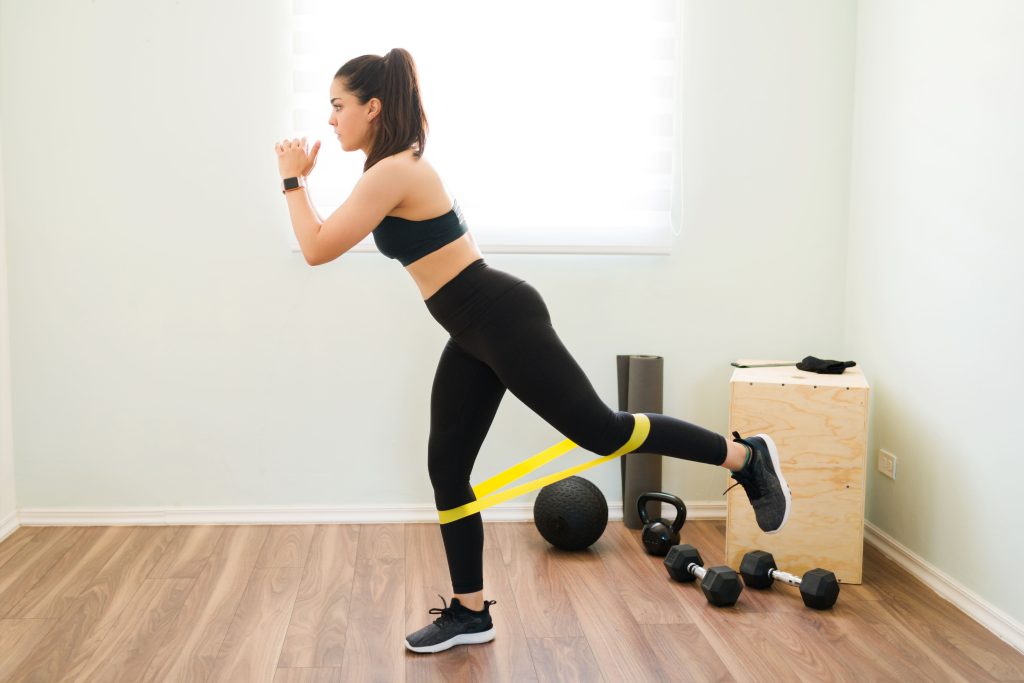18 de April de 2025
Banded Glute Kickbacks: Exercise Guide, Tips and Benefits
Glute strength plays a central role in power, posture, and injury prevention—and banded glute kickbacks are one of the most accessible ways to build it. Whether you’re targeting athletic performance, correcting imbalances, or improving hip function, this exercise offers a simple yet effective solution. With nothing more than a resistance band, you can train critical movement patterns that support strength and stability across your entire kinetic chain.
What Are Banded Glute Kickbacks?
Banded glute kickbacks are an isolation movement that targets the glute muscles, especially the gluteus maximus. Using a resistance band looped around your thighs or ankles, you extend one leg backward while maintaining a stable torso. This action engages the posterior chain and improves neuromuscular control of the hips and core.
This exercise is commonly used in glute activation sequences, warm-ups, or as part of accessory work in both athletic and rehabilitation settings. It helps correct underactive glutes, which are a common culprit in lower back pain, knee instability, and inefficient gait mechanics.

How to Do Banded Glute Kickbacks Properly
Start in a quadruped position (hands and knees on the floor) with a resistance band placed just above your knees or around your ankles. Brace your core and keep your spine neutral. Extend one leg straight back, pushing through your heel and squeezing your glute at the top.
Avoid arching your back or rotating your hips during the movement—your upper body should remain still. Slowly return the leg to the starting position and repeat. Perform all reps on one leg before switching sides. Control and mind-muscle connection are more important than using a thick band or rushing through reps.
Muscles Worked by Banded Glute Kickbacks
- Gluteus Maximus: The primary muscle activated during the hip extension movement.
- Gluteus Medius and Minimus: Assist with pelvic stability and help control rotation.
- Hamstrings: Support hip extension alongside the glutes.
- Core Stabilizers: Engage to maintain a neutral spine and prevent compensation.
These muscles work synergistically to improve posterior chain strength, crucial for sprinting, jumping, and lifting.
Benefits of Banded Glute Kickbacks
This low-impact exercise offers numerous advantages for athletes, lifters, and rehab clients alike. Banded kickbacks are ideal for:
- Enhancing glute activation prior to compound lifts like squats or deadlifts.
- Improving hip extension mechanics for better sprinting and jumping.
- Supporting injury prevention by strengthening muscles that stabilize the pelvis and knees.
- Aiding in muscle hypertrophy and shaping of the glutes with high-rep protocols.
For coaches managing athlete fatigue, banded kickbacks are an excellent low-CNS load accessory that supports posterior development without taxing recovery capacity.

Common Mistakes to Avoid
- Overarching the Lower Back: Compensating with lumbar extension instead of isolating the glutes.
- Poor Core Engagement: Failing to brace can lead to excessive spinal movement.
- Using Momentum: Swinging the leg reduces muscle activation.
- Band Too High or Loose: This decreases resistance and shifts the focus away from the glutes.
Variations of Banded Glute Kickbacks
- Standing Cable Kickbacks: Use a cable machine to apply constant resistance and add load progression.
- Ankle-Band Kickbacks: Increase challenge by positioning the band lower on the leg.
- Straight-Leg Kickbacks: Keep the leg extended for greater glute engagement.
- Mini-Band Diagonal Kickbacks: Add a diagonal vector to target glute medius more effectively.
How to Include Banded Glute Kickbacks in Your S&C Workout
This exercise works well as a warm-up or activation drill before heavy lower-body lifts. It can also be programmed as an accessory in hypertrophy blocks or as part of a rehab protocol. Within a Strength and Conditioning framework, glute kickbacks improve posterior chain recruitment and address imbalances that hinder performance.
While not typically tracked with Velocity Based Training (VBT) devices, understanding movement quality and control in this exercise aligns with principles of Velocity Based Training. These movements are valuable for stability and muscle re-education—especially in periods of deload or recovery.
FAQs About Banded Glute Kickbacks
Are banded kickbacks good for glutes?
Yes, banded glute kickbacks are excellent for targeting and isolating the gluteus maximus. They enhance glute engagement, improve hip extension mechanics, and are highly effective in both warm-up routines and strength-focused workouts.
What is a common mistake for glute kickbacks?
A frequent mistake is overarching the lower back or rotating the hips, which shifts the focus away from the glutes. To avoid this, maintain a neutral spine, engage the core, and move slowly through the full range of motion.
How to do a glute kickback without a machine?
You can perform glute kickbacks on all fours using a resistance band or even just your bodyweight. Focus on slow, controlled leg extensions while maintaining proper posture and core engagement. This version is accessible and effective without the need for gym equipment.
What is the best kickback for glutes?
The best variation depends on your training level and goals. Banded glute kickbacks offer excellent activation, while cable and Smith machine versions provide greater resistance and progressive overload for hypertrophy-focused training.
Banded glute kickbacks may look simple, but their value in improving glute function, joint stability, and overall performance is significant. Whether you’re a beginner or a high-level athlete, this movement can support stronger lifts, healthier hips, and better body mechanics in any Strength and Conditioning program.
